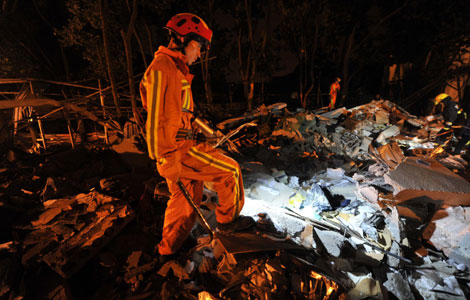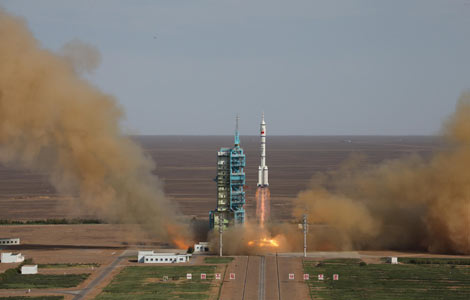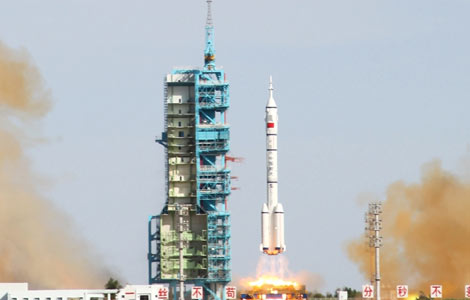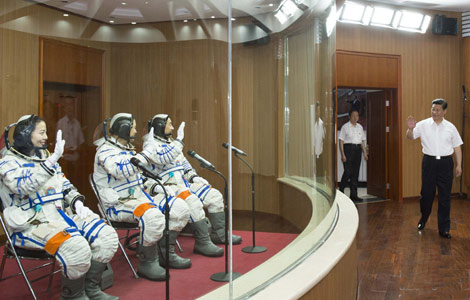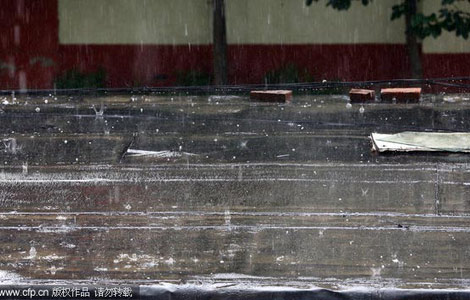
Experts warn several major storms will hit the country this year
At least seven typhoons are expected to hit China this year, the Office of State Flood Control and Drought Relief Headquarters said in May.
Typhoon season runs from July to September, with the most intense storms occurring between August and October.
 |
Zhang Ling, chief typhoon forecaster at the typhoon and marine forecast center under the China Meteorological Administration, said the number of typhoons likely to land in the country is similar to the average number recorded since 1949.
The first typhoon is expected to hit about mid-June, a little earlier than usual, Li Benxia, a typhoon expert at the National Marine Environmental Forecasting Center of the State Oceanic Administration, said.
She said Zhejiang and Fujian provinces, near the East China Sea, may see more than six typhoons, and the local authorities should prepare for a harsh typhoon season.
The South China Sea area is likely to be mild compared with the East China Sea, according to Li.
Experts have warned local authorities to pay close attention to the coming typhoon season, because the severe weather can cause damage and casualties on a massive scale.
CMA Spokesman Chen Zhenlin said heavy rainfall is also expected.
Saomai, one of the deadliest typhoons in China since 1949, struck Zhejiang, Fujian, Jiangxi and Hubei provinces in 2006, killing an estimated 483 people and displacing nearly two million. Direct economic losses reached about 19.7 billion yuan ($ 3.2 billion).
In Fujian, the powerful typhoon lead to 40-meter high waves, sinking more than 400 fishing boats.
Typhoons not only trigger dangerous ocean conditions, but also floods and wild storms with heavy rains and gales, which can flatten buildings and uproot trees.
Impact of typhoons
Zhang said most of the damage caused by typhoons is from rainstorms, gales and storms. She said China is particularly vulnerable to typhoons. .
According to statistics released by the Ministry of Civil Affairs, from 1991 to 2007, typhoons claimed about 456 lives and caused economic losses of more than 33 billion yuan across the country each year.
Zhang said a powerful typhoon can uproot trees, damage buildings and cut off power supplies, threatening human lives.
Heavy rainstorms can trigger floods and mudslides in mountainous regions.
Typhoon expert Li said typhoons can also cause storms at sea, threatening water transportation, the fishing industry and the safety of coastal regions.
The storm surges triggered by Damrey, a typhoon that affected China last year, caused direct economic losses of about 3.6 billion yuan, according to the North China Sea branch of the State Oceanic Administration.
Silver lining
It’s not all bad news, typhoons can also bring benefits such as drought relief and cooler temperatures, Zhang said.
According to statistics released by the CMA, up to 70 percent of precipitation in Fujian, Zhejiang, Guangdong and Guangxi provinces in July and August comes from rainfall triggered by typhoons.
Precipitation can improve the supply of fresh water and bring benefits to the ecological environment in dry regions.
In the hot summer, gales and precipitation caused by typhoons can also cool down hot days, easing the tension in power supply and demand.
In the fishing industry, typhoons can increase fish production, because a typhoon will help nutrients in the deep sea rise, prompting fish to gather near the surface of the water.
Warning system
China has established a typhoon monitoring and forecasting system with data provided by meteorological satellites, radars, monitoring stations and high-performance computers.
The comprehensive system helped CMA reduce its error of 24-hour typhoon tracking forecasts to less than 100 km in 2012. The minimum 24-hour typhoon tracking forecast error was only 94 km.
Zhang said the center can forecast a typhoon within 120 hours, allowing enough time for the affected region to prepare for potential disaster and minimize damage.
Generally after a typhoon alert is issued by CMA, the weather bureaus in affected regions at regional, provincial, city and town or county levels will issue relevant warning signals via television, radio broadcast, text message, telephone, newspaper, Internet and loud speaker.
If the typhoon is expected to be very destructive, local authorities will organize people in affected regions to evacuate according to the local emergency response plan.
The Intergovernmental Panel on Climate Change’s report in 2007 said it is likely that “future tropical cyclones (typhoons and hurricanes) will become more intense, with higher peak wind speeds and more heavier precipitation associated with ongoing sea surface temperature increases”.
Typhoons depend on warm water for energy, so warmer sea surface temperatures in the tropical ocean may lead to longer storm seasons and more frequent strong storms, according to the Center for Ocean Solution, a US-based research center.

